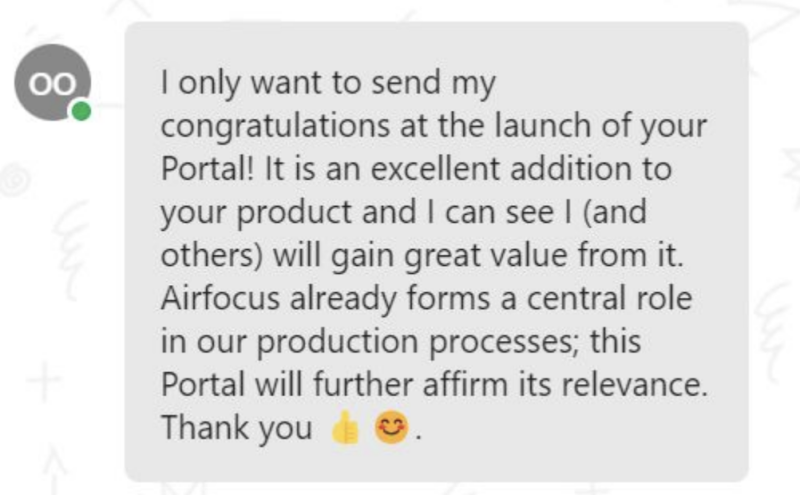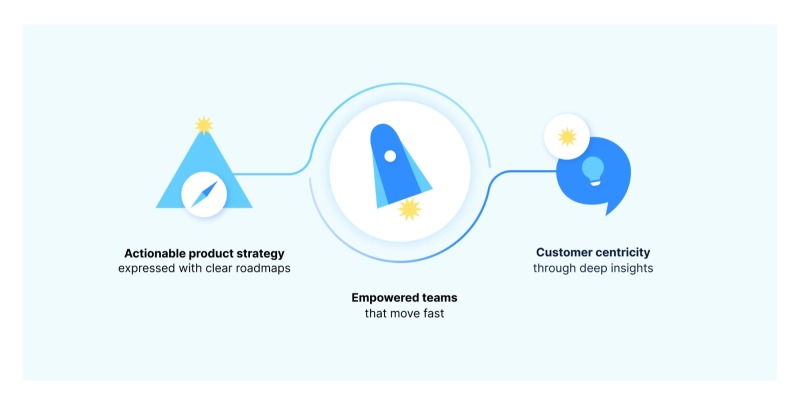
How do we say in product management? A plan is only as good as the reality it survives. When we started into the year, things were certainly looking different than they turned out to be.
That being said, we’d like to share this year’s journey with you and look ahead (at least a little bit). First and foremost, airfocus is a company dedicated to helping teams develop the right product. A product rooted in customer insights and guided by a strong product strategy. So let us talk about the product in 2022 first.
All good things come in threes
One of the big ones is the airfocus Portal, which has been available since April. Portal lets you create a customer-facing website based on the information from your airfocus items so your current and future users can engage with them. It helps you build the products they actually want by closing the feedback loop, whether they’re customers, teammates, or business stakeholders. It not only made us happy, but it also delighted our customers as well.

Another big one was the integration of Status in the core of airfocus. With Status, workspaces now have a dedicated system field to assign status to your items. It comes with standardized status categories with customizable statuses per category to suit your team’s workflows. While this sounds a bit technical, it’s actually quite amazing. You get alignment and a clear view of what needs to be started, what’s in progress, and what’s completed – without the struggle of manually configuring a custom field on every workspace. It provides a holistic view of item progress across hierarchy levels and workspaces. You can also easily track the progress of parent items (like Jira epics) based on how many of its child items (say, Jira stories) have been closed. Pretty “epic”, if you excuse the pun. We wrote a whole other blog post on its inception and challenges from a product management perspective.
As good things (and feature launches) almost always come in threes, we have a third launch we’d like to highlight: the all-new text editor - making descriptions and comments finally fun (again). What is basically a rich text editor, allows you to communicate more effectively, organize information easily, and provide more overall clarity. It comes with a wider array of editing possibilities, such as slash commands, a floating formatting toolbar, drag-and-drop content blocks, and a couple more features. This gives you and your team more ways to present information within items and comments and enables you to have the proper context you need to build the right product faster.
A better airfocus wherever you look
The product manager's life is not only about the class A launches. It’s actually often (all the more so in specialized B2B SaaS like us) about those game-changing user experience improvements. And would you believe it, we made a ton of those.
We hold a firm belief that every product and team is unique and should be allowed to work the way they do. Hence, a lot of our improvements were focused on the features enhancing modularity and increasing flexibility with it. Be it a completely re-vamped sidebar navigation or a much better global search. Press CMD/CTRL + K in airfocus if you haven’t done so yet. While you’re at it, give the refreshed insights, forms, and mirror apps a warm ‘hello’ from us. On top of that, it’s become easier to organize views and the item panel, faster to upgrade your plan and add users (😏) as well as even more straightforward to share your roadmaps.
While we’d love airfocus to be the only one for you, we do know that your stack holds other software as well. That’s why we’ve put a lot of attention into making our Jira integration the best on the market, with flawless hierarchy, two-way sync, and easy-to-get field mapping. The same goes for Azure DevOps, Trello, or the Swiss knife of integrations: Zapier. We’ve also welcomed Slack and Zendesk to the integration family to make your feedback collection much more powerful.
Modern product management with airfocus
Developing a product always comes with a certain attitude to what you’re doing. At airfocus, we’re committed to pushing the whole PM community forward. We provide a truckload of content written by experts in the field to aid you in your daily endeavors. We published an abundance of knowledge on our blog and kept building Product Learn, where everybody can learn about the craft.
We’ve, too, had the pleasure to host John Cutler from Amplitude together with Inês Liberato as well as Sultan Seitbekov from Miro in webinars attended by hundreds of passionate PMs. Not to mention our heated debate if features should be on a roadmap with Andrea Saez, C. Todd Lombardo, and Saeed Khan. And if this isn’t for you, no worries, there are other great events we participated in as well.
One of our own creations makes us immensely proud: the guide to modern product management with airfocus as part of the airfocus academy. The academy is still nascent, but the modern product management creed is clear: empowered teams that move fast, are guided by an actionable strategy, and are rooted in deep customer insights. In the guide, we’ve laid out best practices on how to get the most out of the world’s finest modular product management platform (if we may say so).

Predicting product management in 2023
… is probably as futile as it was the previous year. Just based on the most recent hot trend, it’ll be chat-based AI assistance everywhere. All jokes aside, we’re sure machine-based learning and recommendations are going to turn parts of the product management function upside down in the not-too-distant future for sure. Most likely before the metaverse has been commercialized.
What is certain, is that we’re going to keep building what’s helping our customers build better products. In the near future, we’re committed to CRM integrations to connect product managers better to customer-facing teams, OKR and goal-setting, and airfocus Docs. Moving forward, we’re looking into more integrations with development and task management tools as well as various enhancements to our core value promise of modularity. Looking beyond even that into the later, is, as many a product manager knows, uncertain. Will we work on integrating with your product analytics stack or will we add capacity management? Should we scrap these and add as much “AI” as possible instead? What about the public API we’ve collected insights on already?
The future is uncertain until we’ve experienced it. After a year like 2022, we’re more than ready for 2023. With over 20 new airfolks (and over 200 product memes) on board, we’re certain to master any upcoming challenges beyond expectations - just as we did this year.

Johannes Schneider

Read also



Experience the new way of doing product management

Experience the new way of doing product management




